Physical and Chemical Properties of Fire-Affected Soils from the Sagebrush Ecosystem of the Western US: A Laboratory Study
Abstract
1. Introduction
2. Materials and Methods
2.1. Locations of Fuels and Soil Collection
2.2. Combustion Chamber and On-Line Measurements
2.3. WDPT Measurements
2.4. ACA Measurements
2.5. Reflectance Measurements
2.6. FTIR Measurements
3. Results and Discussion
3.1. Temperature Analysis
3.2. Soil Water Repellency Analysis with WDPT and ACA
3.3. Reflectance Analysis of Samples
3.4. FTIR Analysis of Chemical Functional Groups
3.5. The Link Between Soil Chemistry (FTIR), SWR (ACA), Fire Temperature, and Reflectance
4. Conclusions
Supplementary Materials
Author Contributions
Funding
Institutional Review Board Statement
Informed Consent Statement
Data Availability Statement
Acknowledgments
Conflicts of Interest
Abbreviations
| WUI | Wildland Urban Interface |
| SWR | Soil Water Repellency |
| SOM | Soil Organic Matter |
| WDPT | Water Drop Penetration Time |
| ACA | Apparent Contact Angle |
| FTIR | Fourier-Transform Infrared |
| ASD | Analytical Spectral Devices |
| FOV | Field of View |
| RH | Relative Humidity |
| MSL | Mean Sea Level |
| SB | Sagebrush |
| RB | Rabbitbrush |
| BB | Bitterbrush |
| FT-ICR MS | Fourier-Transform Ion Cyclotron Resonance Mass Spectrometry |
| PAH | Polycyclic Aromatic Hydrocarbon |
| NMR | Nuclear Magnetic Resonance |
References
- Westerling, A.L. Increasing western US forest wildfire activity: Sensitivity to changes in the timing of spring. Philos. Trans. R. Soc. B-Biol. Sci. 2016, 371, 20150178. [Google Scholar] [CrossRef]
- Mueller, S.E.; Thode, A.E.; Margolis, E.Q.; Yocom, L.L.; Young, J.D.; Iniguez, J.M. Climate relationships with increasing wildfire in the southwestern US from 1984 to 2015. For. Ecol. Manag. 2020, 460, 117861. [Google Scholar] [CrossRef]
- Samburova, V.; Schneider, E.; Rüger, C.; Inouye, S.; Sion, B.; Axelrod, K.; Bahdanovich, P.; Friederici, L.; Raeofy, Y.; Berli, M.; et al. Modification of soil hydroscopic and chemical properties caused by four recent California, USA megafires. Fire 2023, 6, 186. [Google Scholar] [CrossRef]
- Raeofy, Y.; Samburova, V.; Berli, M.; Sion, B.; Moosmüller, H. Hyperspectral reflectance and chemical composition of pre- and post-fire soils from three 2021 western USA megafires. Fire 2023, 6, 471. [Google Scholar] [CrossRef]
- Dennison, P.E.; Brewer, S.C.; Arnold, J.D.; Moritz, M.A. Large wildfire trends in the western united states, 1984-2011. Geophys. Res. Lett. 2014, 41, 2928–2933. [Google Scholar] [CrossRef]
- Song, F.H.; Li, T.T.; Hur, J.; Chow, A.T.S.; Leung, K.M.Y.; Wu, F.C. Wildfire-derived pyrogenic organic matter posing overlooked emerging risks to aquatic ecosystems. Environ. Sci. Technol. 2024, 58, 11209–11212. [Google Scholar] [CrossRef] [PubMed]
- History of California Wildfires; Western Fire Chiefs Association (WFCA): Wilsonville, OR, USA, 2022; Available online: https://wfca.com/wildfire-articles/history-of-california-wildfires/ (accessed on 18 September 2025).
- Cova, G.; Kane, V.; Prichard, S.; North, M.; Cansler, A. The outsized role of California’s largest wildfires in changing forest burn patterns and coarsening ecosystem scale. For. Ecol. Manag. 2023, 528, 120620. [Google Scholar] [CrossRef]
- D’Evelyn, S.M.; Jung, J.; Alvarado, E.; Baumgartner, J.; Caligiuri, P.; Hagmann, R.K.; Henderson, S.B.; Hessburg, P.F.; Hopkins, S.; Kasner, E.J.; et al. Wildfire, smoke exposure, human health, and environmental justice need to be integrated into forest restoration and management. Curr. Environ. Health Rep. 2022, 9, 366–385. [Google Scholar] [CrossRef]
- Maya, S.; Thakur, N.; Benmarhnia, T.; Weiser, S.D.; Kahn, J.G. The impact of wildfire smoke on asthma control in California: A microsimulation approach. Geohealth 2024, 8, e2024GH001037. [Google Scholar] [CrossRef] [PubMed]
- Reid, C.E.; Brauer, M.; Johnston, F.H.; Jerrett, M.; Balmes, J.R.; Elliott, C.T. Critical review of health impacts of wildfire smoke exposure. Environ. Health Perspect. 2016, 124, 1334–1343. [Google Scholar] [CrossRef]
- Black, C.; Tesfaigzi, Y.; Bassein, J.A.; Miller, L.A. Wildfire smoke exposure and human health: Significant gaps in research for a growing public health issue. Environ. Toxicol. Pharmacol. 2017, 55, 186–195. [Google Scholar] [CrossRef]
- Radeloff, V.C.; Helmers, D.P.; Kramer, H.A.; Mockrin, M.H.; Alexandre, P.M.; Bar-Massada, A.; Butsic, V.; Hawbaker, T.J.; Martinuzzi, S.; Syphard, A.D.; et al. Rapid growth of the US wildland-urban interface raises wildfire risk. Proc. Natl. Acad. Sci. USA 2018, 115, 3314–3319. [Google Scholar] [CrossRef]
- Innes, R.J. Artemisia tridentata subsp. Vaseyana, Mountain Big Sagebrush. In Fire Effects Information System; U.S. Department of Agriculture, Forest Service, Rocky Mountain Research Station, Fire Sciences Laboratory: Washington, DC, USA, 2017. Available online: https://www.fs.usda.gov/database/feis/plants/shrub/arttriv/all.html (accessed on 18 September 2025).
- Managing Big Sagebrush in Changing Climate. Academic Technology and Outreach|Montana State University MSU. Available online: https://ato.montana.edu/sagebrush/publication.html (accessed on 18 September 2025).
- Sage Steppe Wild. 2025. Available online: https://www.wild-sage.org/projects/sagebrush-steppe (accessed on 18 September 2025).
- Solis, J. Half of Sagebrush Rangelands Are on the Brink of Collapse—Scientists Have a Plan to Revive Them; Nevada Current: Carson, NV, USA, 2024. [Google Scholar]
- Gauna, J. Plant of the Week Sagebrush (Artemisia tridentata nutt.). 2024. Available online: https://www.fs.usda.gov/wildflowers/plant-of-the-week/artemisia_tridentata.shtml (accessed on 18 September 2025).
- Radeloff, V.C.; Mockrin, M.H.; Helmers, D.; Carlson, A.; Hawbaker, T.J.; Martinuzzi, S.; Schug, F.; Alexandre, P.M.; Kramer, H.A.; Pidgeon, A.M. Rising wildfire risk to houses in the united states, especially in grasslands and shrublands. Science 2023, 382, 702–707. [Google Scholar] [CrossRef]
- Bowlin, N. The West’s Worst Fires Aren’t Burning in Forests. 2019. Available online: https://www.hcn.org/issues/51-11/wildfire-the-wests-worst-fires-arent-burning-in-forests/ (accessed on 18 September 2025).
- Clements, C.D.; Freese, M.; McAdoo, C.; Harmon, D. The Martin Fire: Then and Now. 2023. Available online: https://progressiverancher.com/the-martin-fire-then-and-now/ (accessed on 18 September 2025).
- Letey, J. Causes and consequences of fire-induced soil water repellency. Hydrol. Process. 2001, 15, 2867–2875. [Google Scholar] [CrossRef]
- Doerr, S.H.; Woods, S.W.; Martin, D.A.; Casimiro, M. ‘Natural background’ soil water repellency in conifer forests of the north-western USA: Its prediction and relationship to wildfire occurrence. J. Hydrol. 2009, 371, 12–21. [Google Scholar] [CrossRef]
- DeBano, L.F. Water Repellent Soils: A State-of-the-Art; U.S. Department of Agriculture, Forest Service, Pacific Southwest Forest and Range Experiment Station: Washington, DC, USA, 1981. [Google Scholar]
- Debano, L.F.; Krammes, J. Water repellent soils and their relation to wildfire temperatures. Hydrol. Sci. J. 1966, 11, 14–19. [Google Scholar] [CrossRef]
- Atanassova, I.; Doerr, S.H. Changes in soil organic compound composition associated with heat-induced increases in soil water repellency. Eur. J. Soil Sci. 2011, 62, 516–532. [Google Scholar] [CrossRef]
- Doerr, S.H.; Shakesby, R.A.; Walsh, R.P.D. Soil water repellency: Its causes, characteristics and hydro-geomorphological significance. Earth-Sci. Rev. 2000, 51, 33–65. [Google Scholar] [CrossRef]
- Chen, H.; Liu, F.L. Soil depth and recovery interval mediate soil water repellency under different forest types and fire intensity levels in china: Evidence for ecosystem resiliency. Soil Tillage Res. 2024, 237, 105982. [Google Scholar] [CrossRef]
- Cawson, J.G.; Nyman, P.; Smith, H.G.; Lane, P.N.J.; Sheridan, G.J. How soil temperatures during prescribed burning affect soil water repellency, infiltration and erosion. Geoderma 2016, 278, 12–22. [Google Scholar] [CrossRef]
- Samburova, V.; Shillito, R.M.; Berli, M.; Khlystov, A.Y.; Moosmüller, H. Effect of biomass-burning emissions on soil water repellency: A pilot laboratory study. Fire 2021, 4, 24. [Google Scholar] [CrossRef]
- Jordán, A.; González, F.; Zavala, L. Re-establishment of soil water repellency after destruction by intense burning in a Mediterranean heathland (SW Spain). Hydrol. Process. 2010, 24, 736–748. [Google Scholar] [CrossRef]
- DeBano, L. The role of fire and soil heating on water repellency in wildland environments: A review. J. Hydrol. 2000, 231, 195–206. [Google Scholar] [CrossRef]
- Larsen, I.J.; MacDonald, L.H.; Brown, E.; Rough, D.; Welsh, M.J.; Pietraszek, J.H.; Libohova, Z.; de Dios Benavides-Solorio, J.; Schaffrath, K. Causes of post-fire runoff and erosion: Water repellency, cover, or soil sealing? Soil Sci. Soc. Am. J. 2009, 73, 1393–1407. [Google Scholar] [CrossRef]
- Negri, S.; Arcenegui, V.; Mataix-Solera, J.; Bonifacio, E. Extreme water repellency and loss of aggregate stability in heat-affected soils around the globe: Driving factors and their relationships. Catena 2024, 244, 108257. [Google Scholar] [CrossRef]
- DeBano, L.F. Observation on water-reppellent soils in westerns United States. In Proceedings of the Symposium on Water Repellent Soils; DeBano, L.F., Letey, J., Eds.; University of California: Riverside, CA, USA, 1969; pp. 17–29. [Google Scholar]
- DeBano, L.; Savage, S.; Hamilton, D. The transfer of heat and hydrophobic substances during burning. Soil Sci. Soc. Am. J. 1976, 40, 779–782. [Google Scholar] [CrossRef]
- Savage, S.M.; Heaton, C.; Osborn, J.; Letey, J. Substances contributing to fire-induced water repellency in soils. Soil Sci. Soc. Am. Proc. 1972, 36, 674–678. [Google Scholar] [CrossRef]
- Doerr, S.H. On standardizing the ‘water drop penetration time’ and the ‘molarity of an ethanol droplet’ techniques to classify soil hydrophobicity: A case study using medium textured soils. Earth Surf. Process. Landf. 1998, 23, 663–668. [Google Scholar] [CrossRef]
- Letey, J.; Carrillo, M.L.K.; Pang, X.P. Approaches to characterize the degree of water repellency. J. Hydrol. 2000, 231, 61–65. [Google Scholar] [CrossRef]
- Bachmann, J.; Ellies, A.; Hartge, K.H. Development and application of a new sessile drop contact angle method to assess soil water repellency. J. Hydrol. 2000, 231, 66–75. [Google Scholar] [CrossRef]
- Erbil, H.Y. The debate on the dependence of apparent contact angles on drop contact area or three-phase contact line: A review. Surf. Sci. Rep. 2014, 69, 325–365. [Google Scholar] [CrossRef]
- Rosado, B.H.P.; Holder, C.D. The significance of leaf water repellency in ecohydrological research: A review. Ecohydrology 2013, 6, 150–161. [Google Scholar] [CrossRef]
- Morley, C.; Mainwaring, K.; Doerr, S.; Douglas, P.; Llewellyn, C.; Dekker, L. Organic compounds at different depths in a sandy soil and their role in water repellency. Aust. J. Soil Res. 2005, 43, 239–249. [Google Scholar] [CrossRef]
- Dekker, L.W.; Ritsema, C.J. How water moves in a water repellent sandy soil. 1. Potential and actual water repellency. Water Resour. Res. 1994, 30, 2507–2517. [Google Scholar] [CrossRef]
- Scott, D.F. Soil wettability in forested catchments in South Africa; as measured by different methods and as affected by vegetation cover and soil characteristics. J. Hydrol. 2000, 231, 87–104. [Google Scholar] [CrossRef]
- Leelamanie, D.; Karube, J.; Yoshida, A. Characterizing water repellency indices: Contact angle and water drop penetration time of hydrohobized sand. Soil Sci. Plant Nutr. 2008, 54, 179–187. [Google Scholar] [CrossRef]
- de Blas, E.; Rodríguez-Alleres, M.; Almendros, G. Speciation of lipid and humic fractions in soils under pine and eucalyptus forest in northwest Spain and its effect on water repellency. Geoderma 2010, 155, 242–248. [Google Scholar] [CrossRef]
- Williams, C.J.; Pierson, F.B.; Kormos, P.R.; Al-Hamdan, O.Z.; Hardegree, S.P.; Clark, P.E. Ecohydrologic response and recovery of a semi-arid shrubland over a five year period following burning. Catena 2016, 144, 163–176. [Google Scholar] [CrossRef]
- Pierson, F.; Robichaud, P.; Moffet, C.; Spaeth, K.; Williams, C.; Hardegree, S.; Clark, P. Soil water repellency and infiltration in coarse-textured soils of burned and unburned sagebrush ecosystems. Catena 2008, 74, 98–108. [Google Scholar] [CrossRef]
- Glenn, N.F.; Finley, C.D. Fire and vegetation type effects on soil hydrophobicity and infiltration in the sagebrush-steppe: I. Field analysis. J. Arid Environ. 2010, 74, 653–659. [Google Scholar] [CrossRef]
- Dee, S. Preliminary Geologic Map of the Granite Peak Quadrangle; Nevada Bureau of Mines and Geology Open-File Report: Washoe County, NV, USA, 2019; pp. 12–19. [Google Scholar]
- Official Soil Series Descriptions (OSDS); USDA, Natural Resources Conservation Service: Washington, DC, USA, 2025. Available online: https://www.nrcs.usda.gov/resources/data-and-reports/official-soil-series-descriptions-osds (accessed on 18 September 2025).
- McElderry, K. Species Biology of Sagebrush Steppe. 2025. Available online: https://blogs.oregonstate.edu/ (accessed on 18 September 2025).
- Tian, J.; Chow, J.C.; Cao, J.J.; Han, Y.; Ni, H.Y.; Chen, L.W.A.; Wang, X.L.; Huang, R.J.; Moosmüller, H.; Watson, J.G. A biomass combustion chamber: Design, evaluation, and a case study of wheat straw combustion emission tests. Aerosol Air Qual. Res. 2015, 15, 2104–2114. [Google Scholar] [CrossRef]
- Letey, J. Measurement of contact angle, water drop penetration time and critical surface tension. In Proceedings of the Symposium on Water Repellant Soils, Riverside, CA, USA, 6–10 May 1968. [Google Scholar]
- King, P.M. Comparison of methods for measuring severity of water repellence of sandy soils and assessment of some factors that affect its measurement. Aust. J. Soil Res. 1981, 19, 275–285. [Google Scholar] [CrossRef]
- Shillito, R.M.; Berli, M.; Ghezzehei, T.A. Quantifying the effect of subcritical water repellency on sorptivity: A physically based model. Water Resour. Res. 2020, 56, e2020WR027942. [Google Scholar] [CrossRef]
- Enev, V.; Sedlácek, P.; Kubíková, L.; Sovová, S.; Doskocil, L.; Klucáková, M.; Pekar, M. Polarity-based sequential extraction as a simple tool to reveal the structural complexity of humic acids. Agronomy 2021, 11, 587. [Google Scholar] [CrossRef]
- Guillen, M.D.; Iglesias, M.J.; Dominguez, A.; Blanco, C.G. Semiquantitative ftir analysis of a coal-tar pitch and tts extracts and residues in several organic-solvents. Energy Fuels 1992, 6, 518–525. [Google Scholar] [CrossRef]
- Odo, I.; Ezeanyika, L.; Ogugua, V.; Joshua, P.; Okagu, I. FTIR and GC-MS spectroscopic analysis of methanol and chloroform extracts of Brenania brieyi root bark. Am. J. Res. Commun. 2017, 5, 44–54. [Google Scholar]
- Son, Y.; Giovenco, D.P.; Delnevo, C.; Khlystov, A.; Samburova, V.; Meng, Q.Y. Indoor air quality and passive e-cigarette aerosol exposures in vape-shops. Nicotine Tob. Res. 2020, 22, 1772–1779. [Google Scholar] [CrossRef]
- Samburova, V.; Lemos, M.S.; Hiibel, S.; Hoekman, S.K.; Cushman, J.C.; Zielinska, B. Analysis of triacylglycerols and free fatty acids in algae using ultra-performance liquid chromatography mass spectrometry. J. Am. Oil Chem. Soc. 2013, 90, 53–64. [Google Scholar] [CrossRef]
- Liu, J.; Bergin, M.; Guo, H.; King, L.; Kotra, N.; Edgerton, E.; Weber, R.J. Size-resolved measurements of brown carbon in water and methanol extracts and estimates of their contribution to ambient fine-particle light absorption. Atmos. Chem. Phys. 2013, 13, 12389–12404. [Google Scholar] [CrossRef]
- Sengupta, D.; Samburova, V.; Bhattarai, C.; Kirillova, E.; Mazzoleni, L.; Iaukea-Lum, M.; Watts, A.; Moosmüller, H.; Khlystov, A. Light absorption by polar and non-polar aerosol compounds from laboratory biomass combustion. Atmos. Chem. Phys. 2018, 18, 10849–10867. [Google Scholar] [CrossRef]
- Akomeng, N.; Adusei, S. Organic solvent extraction and spectrophotometric quantification of total phenolic content of soil. Heliyon 2021, 7, e08388. [Google Scholar] [CrossRef] [PubMed]
- Cao, T.; Li, M.J.; Zou, C.L.; Fan, X.J.; Song, J.Z.; Jia, W.L.; Yu, C.L.; Yu, Z.Q.; Ping, P.A. Chemical composition, optical properties, and oxidative potential of water- and methanol-soluble organic compounds emitted from the combustion of biomass materials and coal. Atmos. Chem. Phys. 2021, 21, 13187–13205. [Google Scholar] [CrossRef]
- Song, J.; Li, M.; Fan, X.; Zou, C.; Zhu, M.; Jiang, B.; Yu, Z.; Jia, W.; Liao, Y.; Peng, P. Molecular characterization of water- and methanol-soluble organic compounds emitted from residential coal combustion using ultrahigh-resolution electrospray ionization fourier transform ion cyclotron resonance mass spectrometry. Environ. Sci. Technol. 2019, 53, 13607–13617. [Google Scholar] [CrossRef] [PubMed]
- Tfaily, M.M.; Chu, R.K.; Tolic, N.; Roscioli, K.M.; Anderton, C.R.; Pasa-Tolic, L.; Robinson, E.W.; Hess, N.J. Advanced solvent based methods for molecular characterization of soil organic matter by high-resolution mass spectrometry. Anal. Chem. 2015, 87, 5206–5215. [Google Scholar] [CrossRef]
- Pärnpuu, S.; Astover, A.; Tonutare, T.; Penu, P.; Kauer, K. Soil organic matter qualification with FTIR spectroscopy under different soil types in estonia. Geoderma Reg. 2022, 28, e00483. [Google Scholar] [CrossRef]
- Provenzano, M.; Cilenti, A.; Gigliotti, G.; Senesi, N. Spectroscopic investigation on hydrophobic and hydrophilic fractions of dissolved organic matter extracted from soils at different salinities. Clean-Soil Air Water 2008, 36, 748–753. [Google Scholar] [CrossRef]
- Samburova, V.; Szidat, S.; Hueglin, C.; Fisseha, R.; Baltensperger, U.; Zenobi, R.; Kalberer, M. Seasonal variation of high-molecular-weight compounds in the water-soluble fraction of organic urban aerosols. J. Geophys. Res. Atmos. 2005, 110, D23210. [Google Scholar] [CrossRef]
- Chow, A.T.S.; Ulus, Y.; Huang, G.C.; Kline, M.A.; Cheah, W.Y. Challenges in quantifying and characterizing dissolved organic carbon: Sampling, isolation, storage, and analysis. J. Environ. Qual. 2022, 51, 837–871. [Google Scholar] [CrossRef]
- Bahdanovich, P.; Axelrod, K.; Khlystov, A.Y.; Samburova, V. Characterization of organic species and functional groups in pollen, fungi, algae, and bacteria bioaerosols. Environ. Sci. Atmos. 2024, 4, 1091–1104. [Google Scholar] [CrossRef]
- Sullivan, A.L. Inside the inferno: Fundamental processes of wildland fire behaviour: Part 2: Heat transfer and interactions. Curr. For. Rep. 2017, 3, 150–171. [Google Scholar] [CrossRef]
- Fiorini, C.; Craveiro, H.D.; Santiago, A.; Laim, L.; da Silva, L.S. Parametric evaluation of heat transfer mechanisms in a WUI fire scenario. Int. J. Wildland Fire 2023, 32, 1600–1618. [Google Scholar] [CrossRef]
- Oliveira, L.A.; Viegas, D.X.; Raimundo, A.M. Numerical predictions on the soil thermal effect under surface fire conditions. Int. J. Wildland Fire 1997, 7, 51–63. [Google Scholar] [CrossRef]
- DeBano, L.F. Formation of Non-Wettable Soils: Involves Heat Transfer Mechanism; Pacific Southwest Forest & Range Experiment Station: Berkeley, CA, USA, 1966. [Google Scholar]
- Badía, D.; López-García, S.; Martí, C.; Ortíz-Perpiñá, O.; Girona-García, A.; Casanova-Gascón, J. Burn effects on soil properties associated to heat transfer under contrasting moisture content. Sci. Total Environ. 2017, 601, 1119–1128. [Google Scholar] [CrossRef] [PubMed]
- Sirotiak, M.; Bartošová, A. Changes in structure and content humic substances in soil during the laboratory simulated fires. Trans. VSB 2016, 11, 42–48. [Google Scholar] [CrossRef]
- Gimeno-García, E.; Andreu, V.; Rubio, J.L. Spatial patterns of soil temperatures during experimental fires. Geoderma 2004, 118, 17–38. [Google Scholar] [CrossRef]
- Negri, S.; Stanchi, S.; Celi, L.; Bonifacio, E. Simulating wildfires with lab-heating experiments: Drivers and mechanisms of water repellency in alpine soils. Geoderma 2021, 402, 115357. [Google Scholar] [CrossRef]
- Zavala, L.M.; Granged, A.J.P.; Jordán, A.; Bárcenas-Moreno, G. Effect of burning temperature on water repellency and aggregate stability in forest soils under laboratory conditions. Geoderma 2010, 158, 366–374. [Google Scholar] [CrossRef]
- Rundel, P.W. Impact of fire on nutrient cycles in mediterranean-type ecosystems with reference to chaparral. Ecol. Stud. 1983, 43, 192–207. [Google Scholar]
- McGhie, D.; Posner, A. The effect of plant top material on the water repellence of fired sands and water repellent soils. Aust. J. Agric. Res. 1981, 32, 609–620. [Google Scholar] [CrossRef]
- Kainulainen, P.; Holopainen, J.K. Concentrations of secondary compounds in Scots pine needles at different stages of decomposition. Soil Biol. Biochem. 2002, 34, 37–42. [Google Scholar] [CrossRef]
- Kelleher, B.P.; Simpson, M.J.; Simpson, A.J. Assessing the fate and transformation of plant residues in the terrestrial environment using HR-MAS NMR spectroscopy. Geochim. Cosmochim. Acta 2006, 70, 4080–4094. [Google Scholar] [CrossRef]
- Asuero, A.; Sayago, A.; González, A. The correlation coefficient: An overview. Crit. Rev. Anal. Chem. 2006, 36, 41–59. [Google Scholar] [CrossRef]
- Wang, Z.F.; Wallach, R. Effects of time-dependent contact angle on wettability of subcritically water-repellent soils. Water Resour. Res. 2020, 56, e2020WR027314. [Google Scholar] [CrossRef]
- Simkovic, I.; Dlapa, P.; Doerr, S.H.; Mataix-Solera, J.; Sasinkova, V. Thermal destruction of soil water repellency and associated changes to soil organic matter as observed by FTIR spectroscopy. Catena 2008, 74, 205–211. [Google Scholar] [CrossRef]
- Badía-Villas, D.; González-Pérez, J.; Aznar, J.; Arjona-Gracia, B.; Marti-Dalmau, C. Changes in water repellency, aggregation and organic matter of a mollic horizon burned in laboratory: Soil depth affected by fire. Geoderma 2014, 213, 400–407. [Google Scholar] [CrossRef]
- Brook, A.; Wittenberg, L. Ash-soil interface: Mineralogical composition and physical structure. Sci. Total Environ. 2016, 572, 1403–1413. [Google Scholar] [CrossRef]
- Dlapa, P.; Bodí, M.B.; Mataix-Solera, J.; Cerdà, A.; Doerr, S.H. FT-IR spectroscopy reveals that ash water repellency is highly dependent on ash chemical composition. Catena 2013, 108, 35–43. [Google Scholar] [CrossRef]
- Bodí, M.B.; Martin, D.A.; Balfour, V.N.; Santín, C.; Doerr, S.H.; Pereira, P.; Cerdà, A.; Mataix-Solera, J. Wild land fire ash: Production, composition and eco-hydro-geomorphic effects. Earth-Sci. Rev. 2014, 130, 103–127. [Google Scholar] [CrossRef]
- Roy, D.P.; Boschetti, L.; Maier, S.W.; Smith, A.M.S. Field estimation of ash and char colour-lightness using a standard grey scale. Int. J. Wildland Fire 2010, 19, 698–704. [Google Scholar] [CrossRef]
- Mataix-Solera, J.; Doerr, S.H. Hydrophobicity and aggregate stability in calcareous topsoils from fire-affected pine forests in southeastern Spain. Geoderma 2004, 118, 77–88. [Google Scholar] [CrossRef]
- Pereira, P.; Ubeda, X.; Martin, D.A. Fire severity effects on ash chemical composition and water-extractable elements. Geoderma 2012, 191, 105–114. [Google Scholar] [CrossRef]
- Yin, C.M.; He, B.B.; Quan, X.W.; Yebra, M.; Lai, G.K. Remote sensing of burn severity using coupled radiative transfer model: A case study on Chinese Qinyuan Pine fires. Remote Sens. 2020, 12, 3590. [Google Scholar] [CrossRef]
- Pleniou, M.; Koutsias, N. Sensitivity of spectral reflectance values to different burn and vegetation ratios: A multi-scale approach applied in a fire affected area. ISPRS J. Photogramm. Remote Sens. 2013, 79, 199–210. [Google Scholar] [CrossRef]
- Beltrán-Marcos, D.; Suárez-Seoane, S.; Fernández-Guisuraga, J.M.; Fernández-García, V.; Pinto, R.; García-Llamas, P.; Calvo, L. Mapping soil burn severity at very high spatial resolution from unmanned aerial vehicles. Forests 2021, 12, 179. [Google Scholar] [CrossRef]
- Lugassi, R.; Ben-Dor, E.; Eshel, G. A spectral-based method for reconstructing spatial distributions of soil surface temperature during simulated fire events. Remote Sens. Environ. 2010, 114, 322–331. [Google Scholar] [CrossRef]
- Mastrolonardo, G.; Francioso, O.; Di Foggia, M.; Bonora, S.; Rumpel, C.; Certini, G. Application of thermal and spectroscopic techniques to assess fire-induced changes to soil organic matter in a Mediterranean forest. J. Geochem. Explor. 2014, 143, 174–182. [Google Scholar] [CrossRef]
- Jiménez-Morillo, N.T.; Almendros, G.; De la Rosa, J.M.; Jordán, A.; Zavala, L.M.; Granged, A.J.P.; González-Pérez, J.A. Effect of a wildfire and of post-fire restoration actions in the organic matter structure in soil fractions. Sci. Total Environ. 2020, 728, 138715. [Google Scholar] [CrossRef]
- Badertscher, M.; Bühlmann, P.; Pretsch, E. Structure Determination of Organic Compounds: Tables of Spectral Data; Springer: Berlin/Heidelberg, Germany, 2009. [Google Scholar]
- Devangsari, I.; Nurudin, M.; Sartohadi, J.; Karmila, Y. Characteristics of peat functional group in Padang Island, Indonesia. IOP Conf. Ser. Earth Environ. Sci. 2022, 1005, 012022. [Google Scholar] [CrossRef]
- Parolo, M.E.; Savini, M.C.; Loewy, R.M. Characterization of soil organic matter by FT-IR spectroscopy and its relationship with chlorpyrifos sorption. J. Environ. Manag. 2017, 196, 316–322. [Google Scholar] [CrossRef]
- Heller, C.; Ellerbrock, R.H.; Rosskopf, N.; Klingenfuss, C.; Zeitz, J. Soil organic matter characterization of temperate peatland soil with FTIR-spectroscopy: Effects of mire type and drainage intensity. Eur. J. Soil Sci. 2015, 66, 847–858. [Google Scholar] [CrossRef]
- Araya, S.N.; Fogel, M.L.; Berhe, A.A. Thermal alteration of soil organic matter properties: A systematic study to infer response of Sierra Nevada climosequence soils to forest fires. Soil 2017, 3, 31–44. [Google Scholar] [CrossRef]
- Capriel, P.; Beck, T.; Borchert, H.; Gronholz, J.; Zachmann, G. Hydrophobicity of the organic-matter in arable soils. Soil Biol. Biochem. 1995, 27, 1453–1458. [Google Scholar] [CrossRef]
- Supic, S.; Malesev, M.; Radonjanin, V.; Bulatovic, V.; Milovic, T. Reactivity and pozzolanic properties of biomass ashes generated by wheat and soybean straw combustion. Materials 2021, 14, 1004. [Google Scholar] [CrossRef]
- Azkorra, Z.; Aizpurua, A.; Riga, P.; Heras, P.; Ibargoitia, M.; Gallejones, P.; Gartzia, N.; González, A.; Arbestain, M.C. Characterisation of organic carbon in mire and heath soils at the Elgea-Urkilla Wind Farm, northern Spain. Mires Peat 2008, 4, 5–11. [Google Scholar]
- Hong, H.L.; Chen, S.L.; Fang, Q.; Algeo, T.J.; Zhao, L.L. Adsorption of organic matter on clay minerals in the Dajiuhu peat soil chronosequence, South China. Appl. Clay Sci. 2019, 178, 105125. [Google Scholar] [CrossRef]
- Provenzano, M.R.; Gigliotti, G.; Cilenti, A.; Erriquens, F.; Senesi, N. Spectroscopic and thermal investigation of hydrophobic and hydrophilic fractions of dissolved organic matter. Compos. Sci. Util. 2006, 14, 191–200. [Google Scholar] [CrossRef]
- Kalembkiewicz, J.; Galas, D.; Sitarz-Palczak, E. The physicochemical properties and composition of biomass ash and evaluating directions of its applications. Pol. J. Environ. Stud. 2018, 27, 2593–2603. [Google Scholar] [CrossRef]
- Celi, L.; Schnitzer, M.; Negre, M. Analysis of carboxyl groups in soil humic acids by a wet chemical method, fourier-transform infrared spectrophotometry, and solution-state carbon-13 nuclear magnetic resonance. A comparative study. Soil Sci. 1997, 162, 189–197. [Google Scholar] [CrossRef]
- Kaiser, M.; Ellerbrock, R.H.; Gerke, H.H. Long-term effects of crop rotation and fertilization on soil organic matter composition. Eur. J. Soil Sci. 2007, 58, 1460–1470. [Google Scholar] [CrossRef]
- Benitesa, V.D.; Mendonça, E.D.; Schaefer, C.E.G.R.; Novotny, E.H.; Reis, E.L.; Ker, J.C. Properties of black soil humic acids from high altitude rocky complexes in Brazil. Geoderma 2005, 127, 104–113. [Google Scholar] [CrossRef]
- Tkachenko, Y.; Niedzielski, P. FTIR as a method for qualitative assessment of solid samples in geochemical research: A review. Molecules 2022, 27, 8846. [Google Scholar] [CrossRef] [PubMed]
- Lu, S.; Dosseto, A.; Lemarchand, D.; Dlapa, P.; Simkovic, I.; Bradstock, R. Investigating boron isotopes and FTIR as proxies for bushfire severity. Catena 2022, 219, 106621. [Google Scholar] [CrossRef]
- Ryan, R.; Dosseto, A.; Lemarchand, D.; Dlapa, P.; Thomas, Z.; Simkovic, I.; Bradstock, R. Boron isotopes and FTIR spectroscopy to identify past high severity fires. Catena 2023, 222, 106887. [Google Scholar] [CrossRef]
- Bárcenas-Moreno, G.; Jiménez-Compán, E.; Emeterio, L.M.S.; Jiménez-Morillo, N.T.; González-Pérez, J.A. Soil pH and soluble organic matter shifts exerted by heating affect microbial response. Int. J. Environ. Res. Public Health 2022, 19, 15751. [Google Scholar] [CrossRef]
- Margenot, A.J.; Calderón, F.J.; Goyne, K.W.; Dmukome, F.N.; Parikh, S. IR Spectroscopy, Soil Analysis Applications; Elsevier: Amsterdam, The Netherlands, 2016; pp. 448–454. [Google Scholar]
- Tinoco, P.; Almendros, G.; Sanz, J.; González-Vázquez, R.; González-Vila, F.J. Molecular descriptors of the effect of fire on soils under pine forest in two continental Mediterranean soils. Org. Geochem. 2006, 37, 1995–2018. [Google Scholar] [CrossRef]
- Vergnoux, A.; Guiliano, M.; Di Rocco, R.; Domeizel, M.; Théraulaz, F.; Doumenq, P. Quantitative and mid-infrared changes of humic substances from burned soils. Environ. Res. 2011, 111, 205–214. [Google Scholar] [CrossRef]
- Diniz, Y.V.D.G.; de Oliveira, A.P.P.; da Silva, T.P.; Neto, E.C.D.; Garcia, A.C.; Pereira, M.G.; Motta, M.S.; Fagundes, H.D.; dos Santos, O.A.Q.; dos Anjos, L.H.C. Prescribed fire application in a Brazilian mountain environment: Changes in soil organic matter quality in the short and medium term. Catena 2023, 232, 107418. [Google Scholar] [CrossRef]
- Rossi, C.Q.; Pereira, M.G.; García, A.C.; Berbara, R.L.L.; Gazolla, P.R.; Perin, A.; González, A.P. Effects on the composition and structural properties of the humified organic matter of soil in sugarcane strawburning: A chronosequence study in the Brazilian Cerrado of Goias State. Agric. Ecosyst. Environ. 2016, 216, 34–43. [Google Scholar] [CrossRef]
- Matejková, S.; Simon, T. Application of FTIR spectroscopy for evaluation of hydrophobic/hydrophilic organic components in arable soil. Plant Soil Environ. 2012, 58, 192–195. [Google Scholar] [CrossRef]
- Atanassova, I.; Doerr, S.H. Organic compounds of different extractability in total solvent extracts from soils of contrasting water repellency. Eur. J. Soil Sci. 2010, 61, 298–313. [Google Scholar] [CrossRef]
- Wu, Y.C.; Zhang, N.; Slater, G.; Waddington, J.M.; de Lannoy, C.F. Hydrophobicity of peat soils: Characterization of organic compound changes associated with heat-induced water repellency. Sci. Total Environ. 2020, 714, 136444. [Google Scholar] [CrossRef]
- González-Pérez, J.A.; González-Vila, F.J.; Almendros, G.; Knicker, H. The effect of fire on soil organic matter—A review. Environ. Int. 2004, 30, 855–870. [Google Scholar] [CrossRef]
- Dymov, A.A.; Startsev, V.V.; Milanovsky, E.Y.; Valdes-Korovkin, I.A.; Farkhodov, Y.R.; Yudina, A.V.; Donnerhack, O.; Guggenberger, G. Soils and soil organic matter transformations during the two years after a low-intensity surface fire (Subpolar Ural, Russia). Geoderma 2021, 404, 115278. [Google Scholar] [CrossRef]
- Chen, H.; Chow, A.T.; Li, X.W.; Ni, H.G.; Dahlgren, R.A.; Zeng, H.; Wang, J.J. Wildfire burn intensity affects the quantity and speciation of polycyclic aromatic hydrocarbons in soils. Acs Earth Space Chem. 2018, 2, 1262–1270. [Google Scholar] [CrossRef]
- Campos, I.; Abrantes, N.; Pereira, P.; Micaelo, A.C.; Vale, C.; Keizer, J.J. Forest fires as potential triggers for production and mobilization of polycyclic aromatic hydrocarbons to the terrestrial ecosystem. Land Degrad. Dev. 2019, 30, 2360–2370. [Google Scholar] [CrossRef]
- Dymov, A.A.; Gabov, D.N.; Milanovskii, E.Y. 13C-NMR, PAHs, WSOC and water repellence of fire-affected soils (Albic Podzols) in lichen pine forests, Russia. Environ. Earth Sci. 2017, 76, 275. [Google Scholar] [CrossRef]
- Jiménez-González, M.A.; De la Rosa, J.M.; Jiménez-Morillo, N.T.; Almendros, G.; González-Pérez, J.A.; Knicker, H. Post-fire recovery of soil organic matter in a Cambisol from typical Mediterranean forest in Southwestern Spain. Sci. Total Environ. 2016, 572, 1414–1421. [Google Scholar] [CrossRef] [PubMed]
- Abney, R.B.; Kuhn, T.J.; Chow, A.; Hockaday, W.; Fogel, M.L.; Berhe, A.A. Pyrogenic carbon erosion after the Rim Fire, Yosemite National Park: The role of burn severity and slope. J. Geophys. Res.-Biogeosci. 2019, 124, 432–449. [Google Scholar] [CrossRef]
- Jiménez-Morillo, N.T.; de la Rosa, J.M.; Waggoner, D.; Almendros, G.; González-Vila, F.J.; González-Pérez, J.A. Fire effects in the molecular structure of soil organic matter fractions under cover. Catena 2016, 145, 266–273. [Google Scholar] [CrossRef]
- Vergnoux, A.; Di Rocco, R.; Domeizel, M.; Guiliano, M.; Doumenq, P.; Théraulaz, F. Effects of forest fires on water extractable organic matter and humic substances from mediterranean soils: UV-vis and fluorescence spectroscopy approaches. Geoderma 2011, 160, 434–443. [Google Scholar] [CrossRef]
- Atanassova, I.; Doerr, S.; Bryant, R. Changes in organic compound composition in soil following heating to maximum soil water repellency under anoxic conditions. Environ. Chem. 2012, 9, 369–378. [Google Scholar] [CrossRef]
- Rey-Salgueiro, L.; Martínez-Carballo, E.; Merino, A.; Vega, J.A.; Fonturbel, M.T.; Simal-Gandara, J. Polycyclic aromatic hydrocarbons in soil organic horizons depending on the soil burn severity and type of ecosystem. Land Degrad. Dev. 2018, 29, 2112–2123. [Google Scholar] [CrossRef]
- Vila-Escalé, M.; Vegas-Vilarrúbia, T.; Prat, N. Release of polycyclic aromatic compounds into a Mediterranean creek (Catalonia, NE Spain) after a forest fire. Water Res. 2007, 41, 2171–2179. [Google Scholar] [CrossRef]
- González-Pérez, J.A.; Almendros, G.; de la Rosa, J.M.; González-Vila, F.J. Appraisal of polycyclic aromatic hydrocarbons (PAHs) in environmental matrices by analytical pyrolysis (Py-GC/MS). J. Anal. Appl. Pyrolysis 2014, 109, 1–8. [Google Scholar] [CrossRef]
- Knicker, H. Pyrogenic organic matter in soil: Its origin and occurrence, its chemistry and survival in soil environments. Quat. Int. 2011, 243, 251–263. [Google Scholar] [CrossRef]
- McKissock, I.; Gilkes, R.J.; van Bronswijk, W. The relationship of soil water repellency to aliphatic C and kaolin measured using DRIFT. Aust. J. Soil Res. 2003, 41, 251–265. [Google Scholar] [CrossRef]
- Simkovic, I.; Dlapa, P.; Feketeová, Z. Application of infrared spectroscopy and thermal analysis in explaining the variability of soil water repellency. Appl. Sci. 2023, 13, 216. [Google Scholar] [CrossRef]
- Finley, C.D.; Glenn, N.F. Fire and vegetation type effects on soil hydrophobicity and infiltration in the sagebrush-steppe: II. Hyperspectral analysis. J. Arid Environ. 2010, 74, 660–666. [Google Scholar] [CrossRef]
- Yu, H.; Kong, B.; Wang, Q.; Liu, X.; Liu, X. Hyperspectral remote sensing applications in soil: A review. In Hyperspectral Remote Sensing; Elsevier: Amsterdam, The Netherlands, 2020; pp. 269–291. [Google Scholar]
- Lewis, S.A.; Robichaud, P.R.; Frazier, B.E.; Wu, J.Q.; Laes, D.Y.M. Using hyperspectral imagery to predict post-wildfire soil water repellency. Geomorphology 2008, 95, 192–205. [Google Scholar] [CrossRef]
- Finn, M.P.; Lewis, M.; Bosch, D.D.; Giraldo, M.; Yamamoto, K.; Sullivan, D.G.; Kincaid, R. Remote sensing of soil moisture using airborne hyperspectral data. Gisci. Remote Sens. 2011, 48, 522–540. [Google Scholar] [CrossRef]
- Rennie, M.; Samburova, V.; Sengupta, D.; Bhattarai, C.; Arnott, W.P.; Khlystov, A.; Moosmüller, H. Emissions from the open laboratory combustion of cheatgrass (Bromus tectorum). Atmosphere 2020, 11, 406. [Google Scholar] [CrossRef]
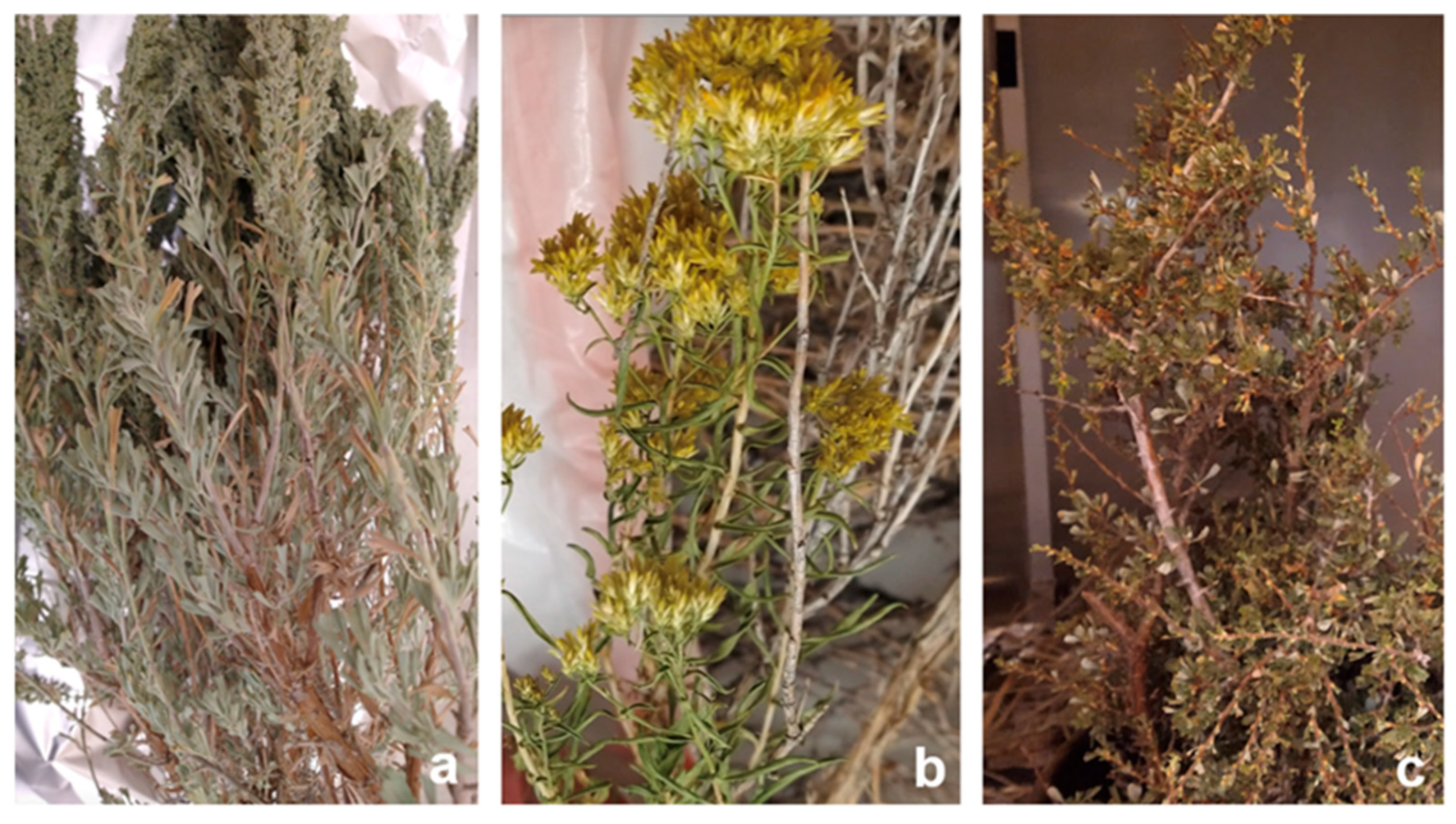

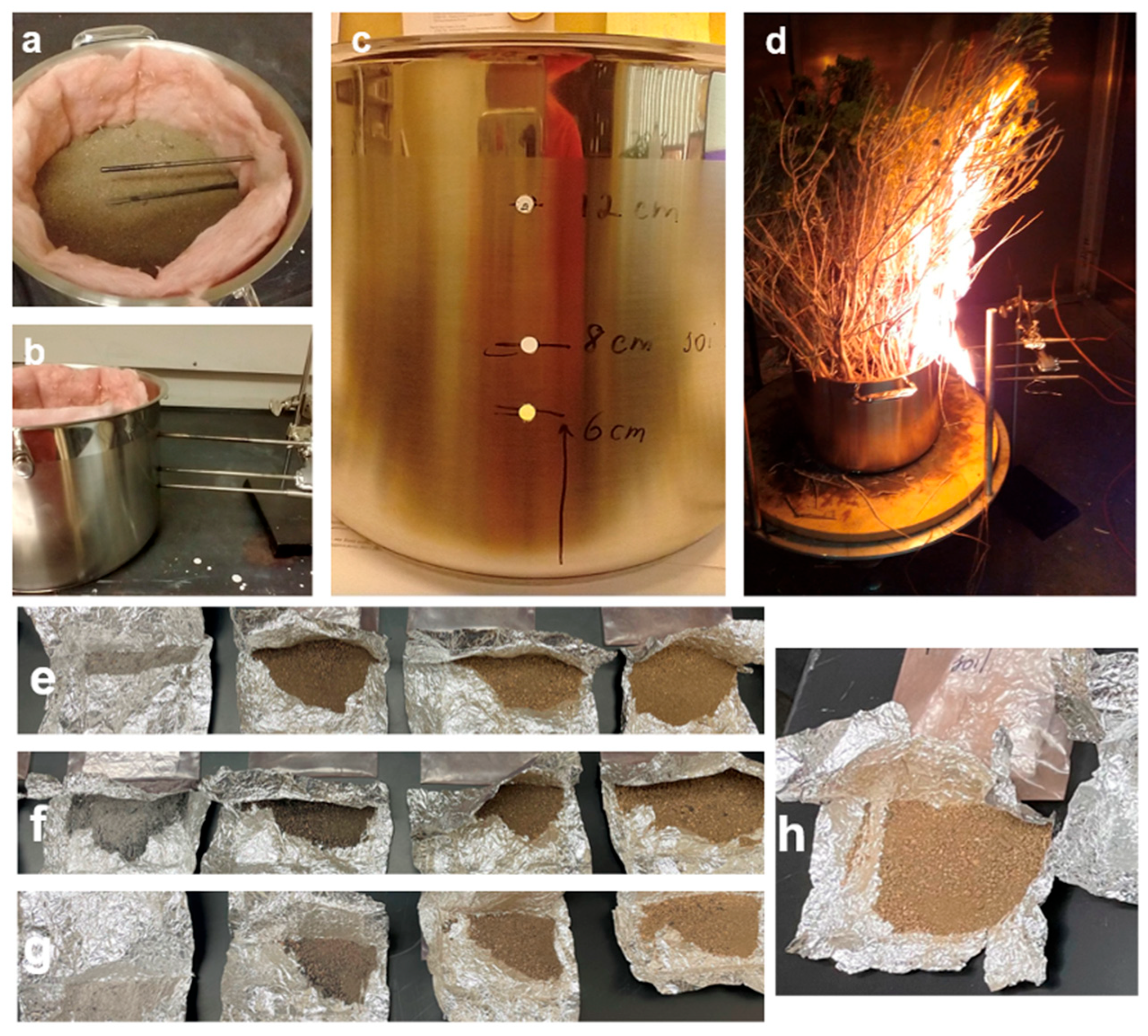
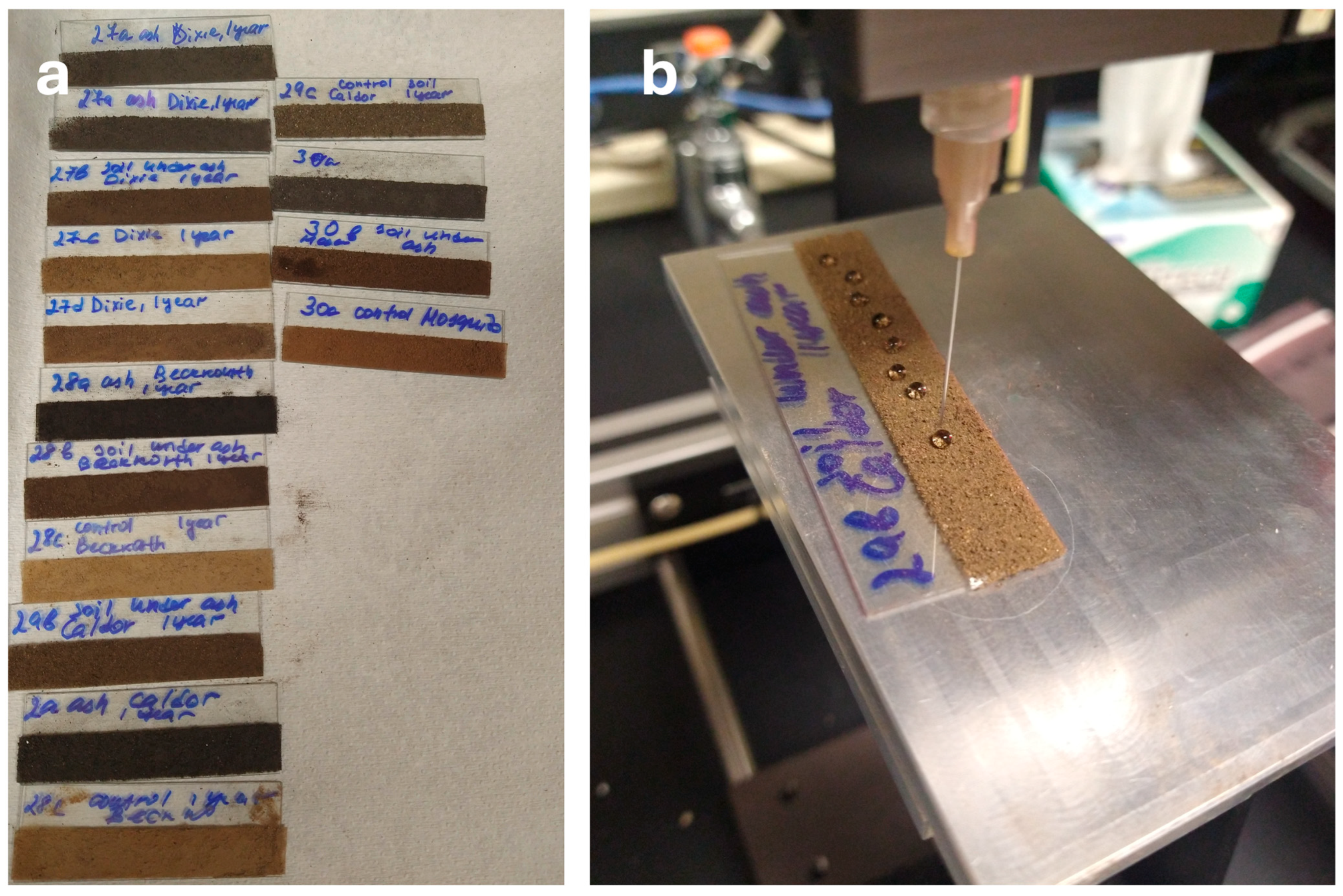
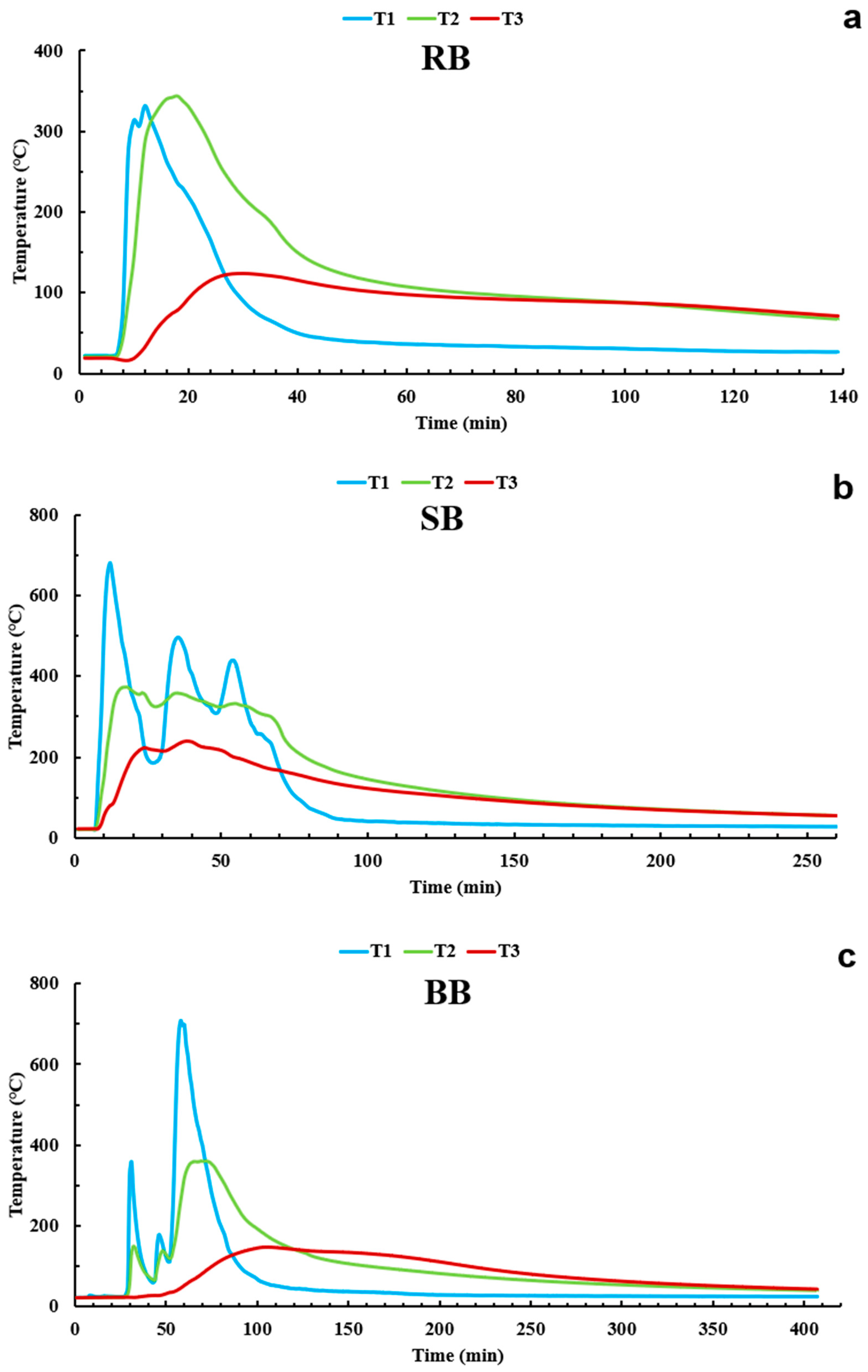
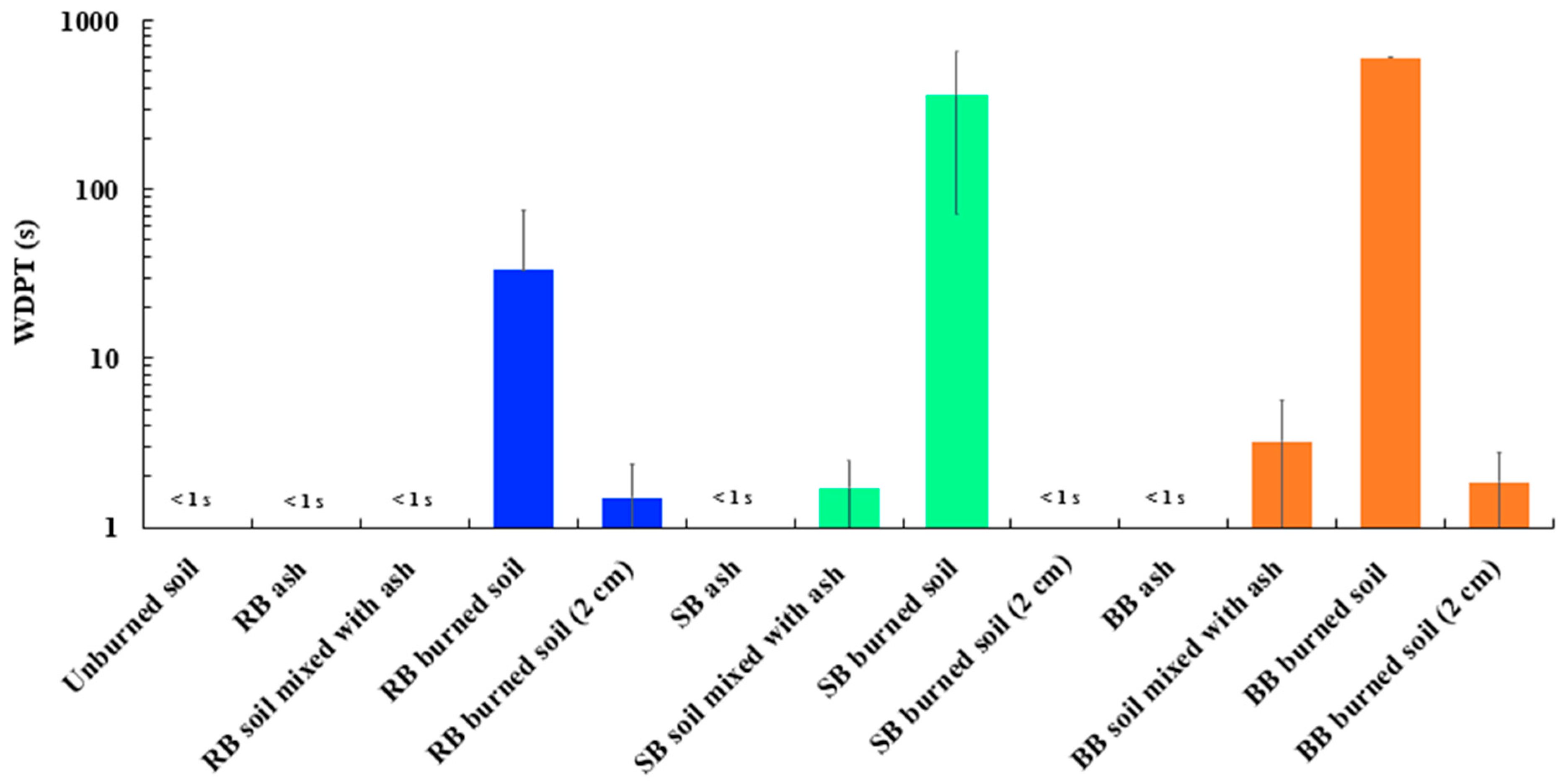
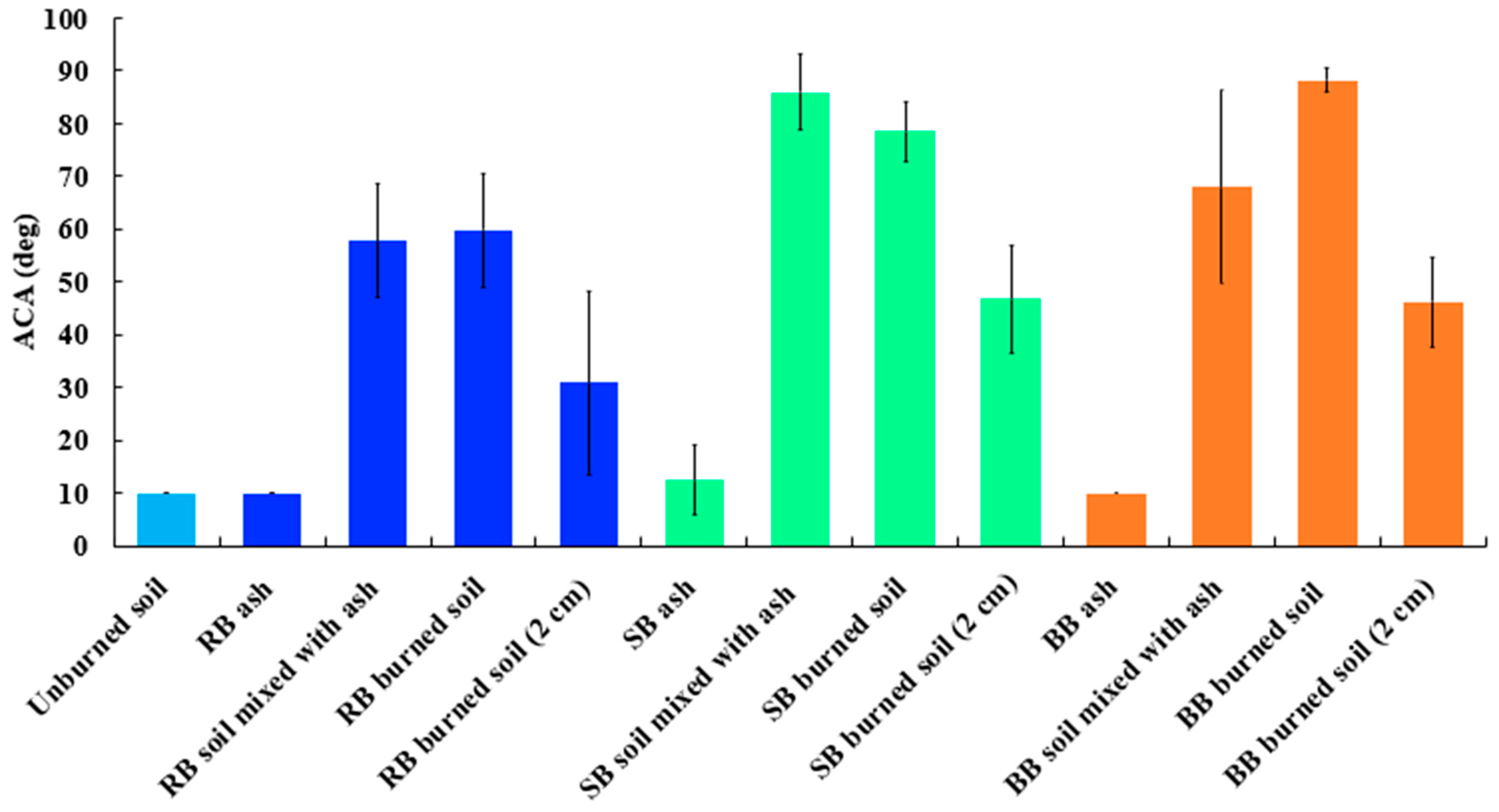

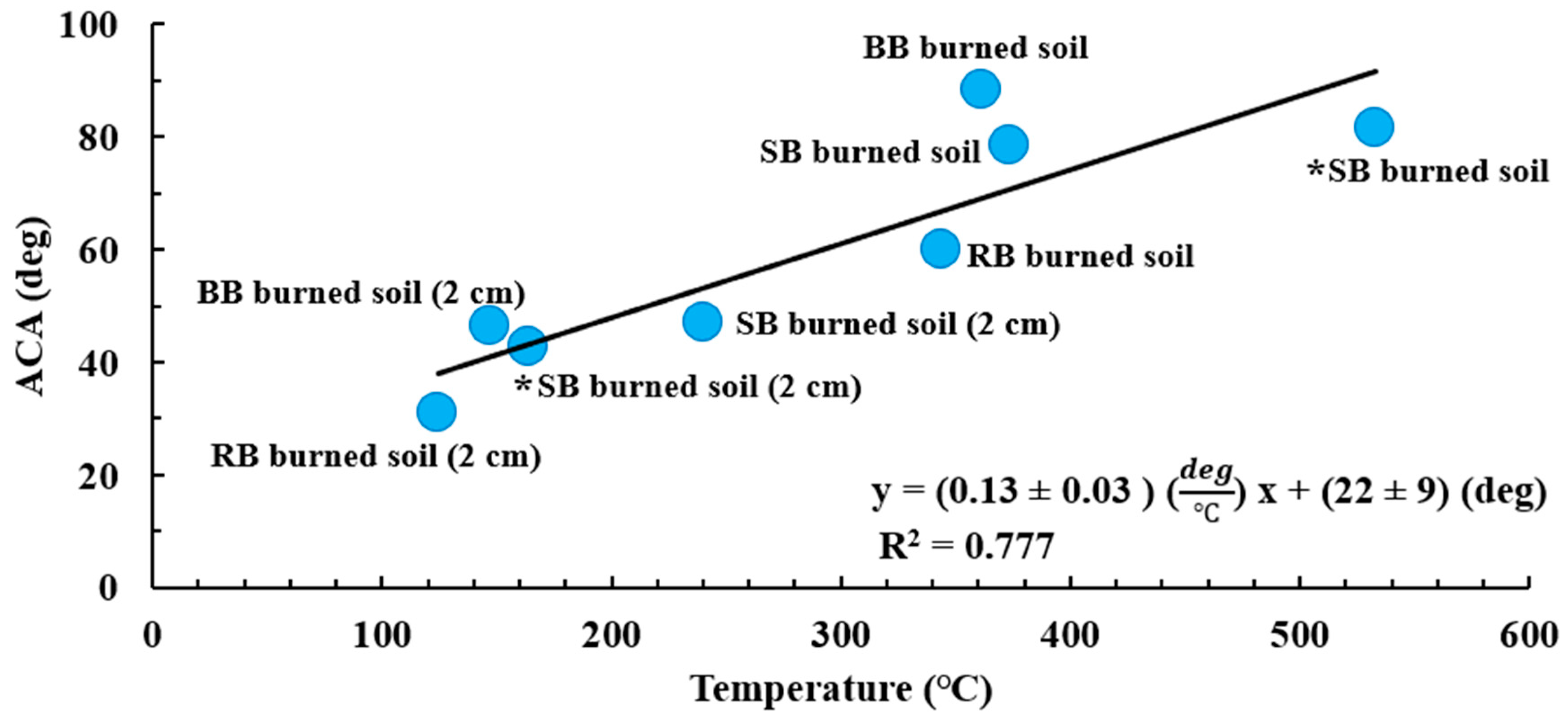

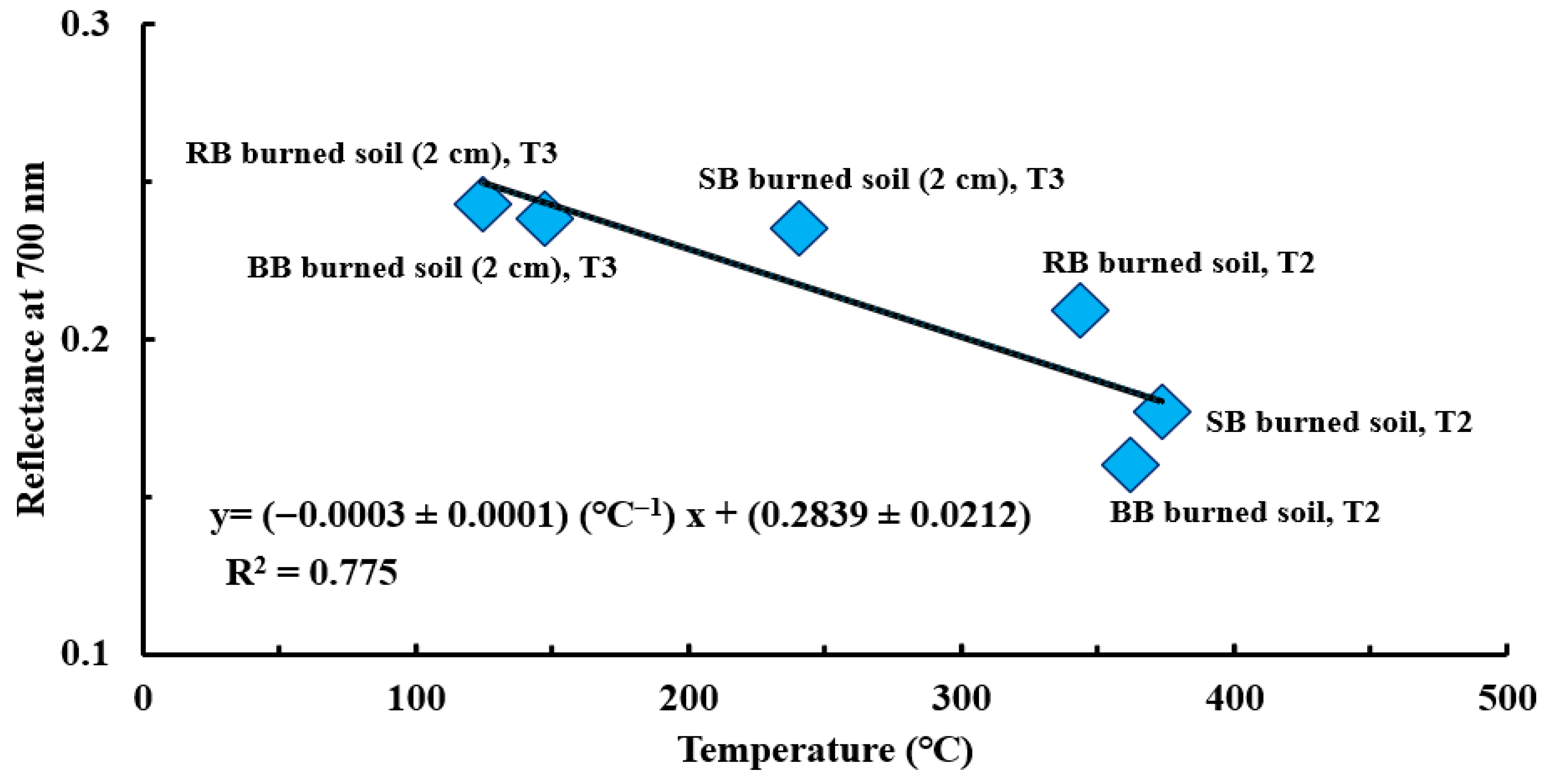
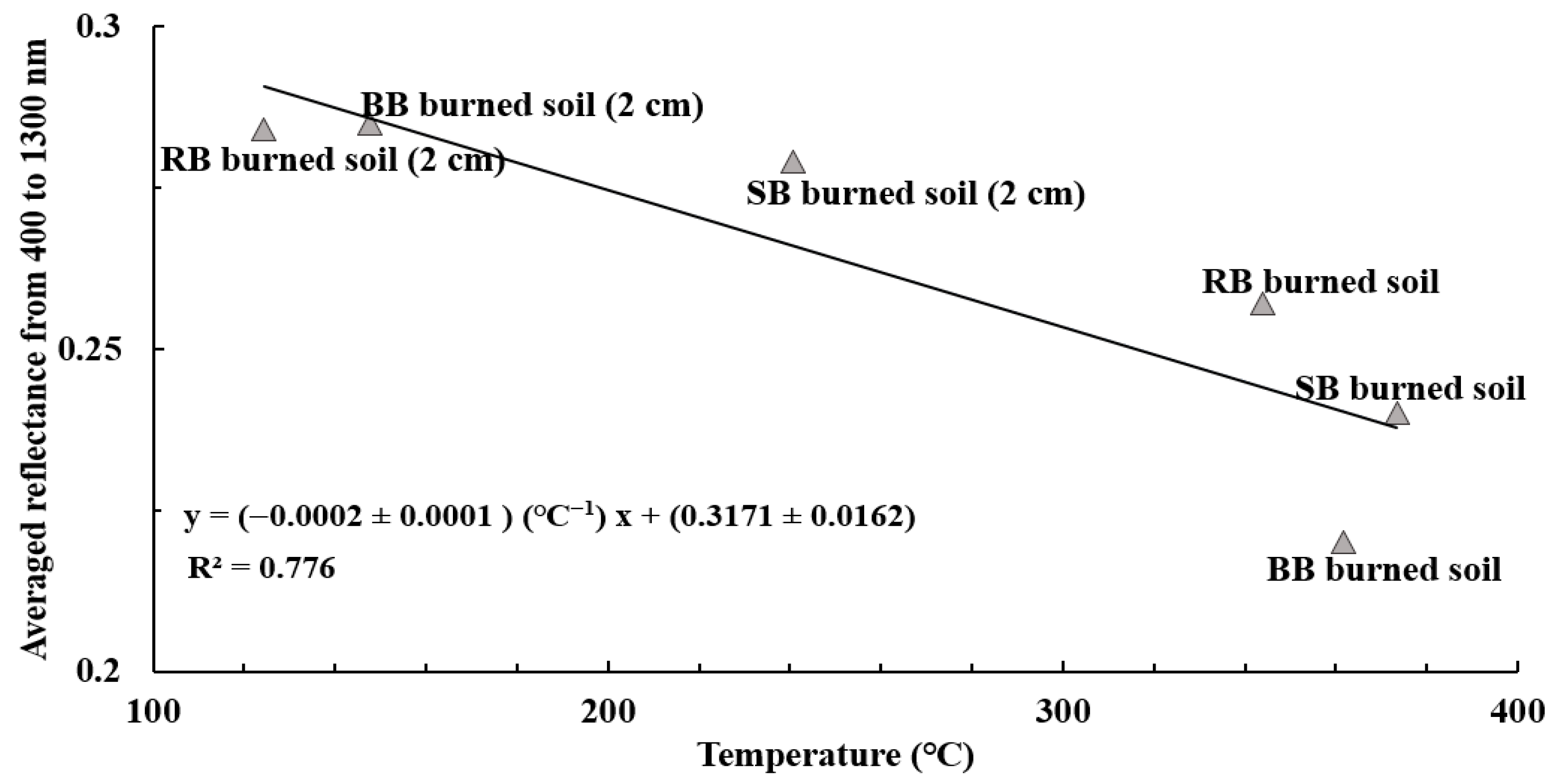
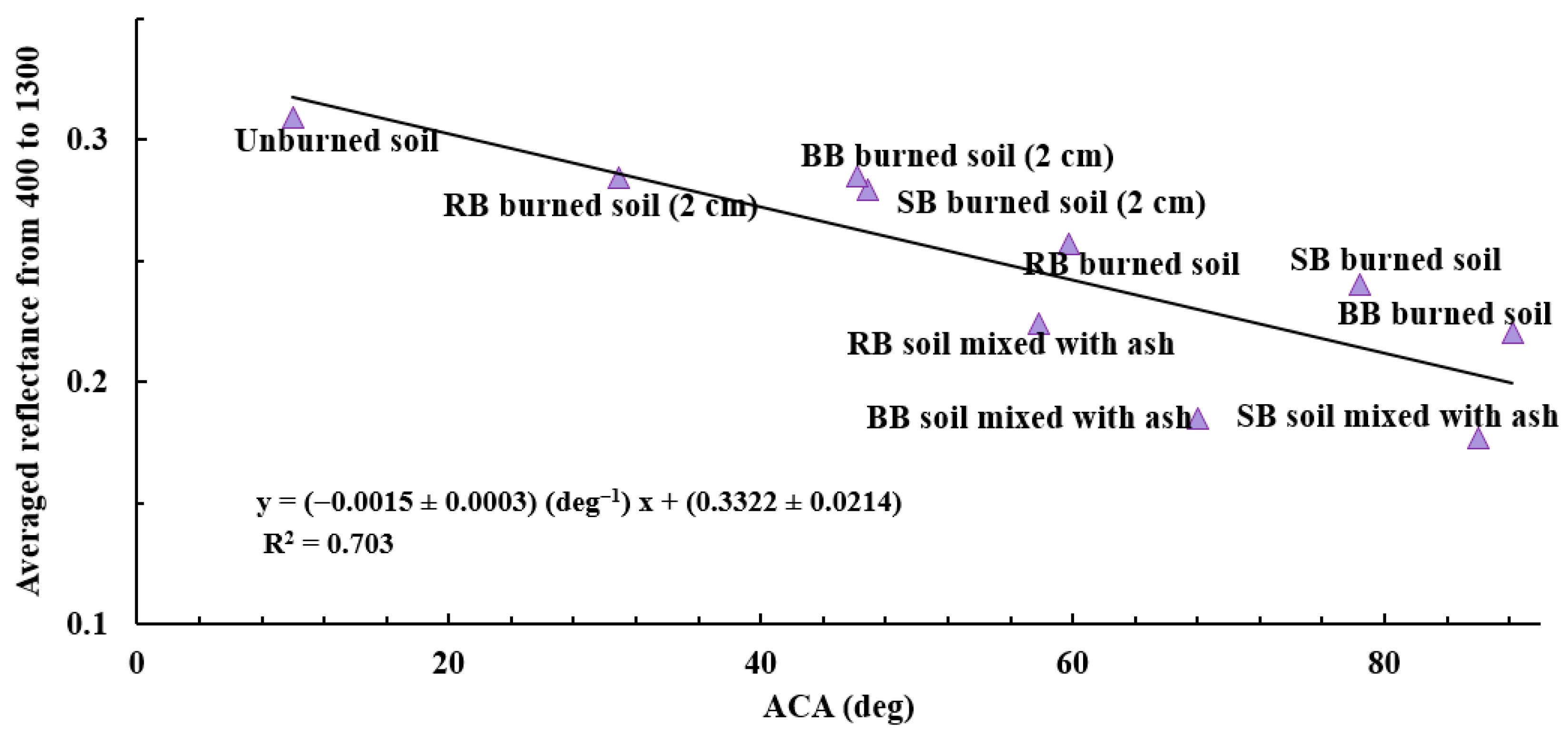

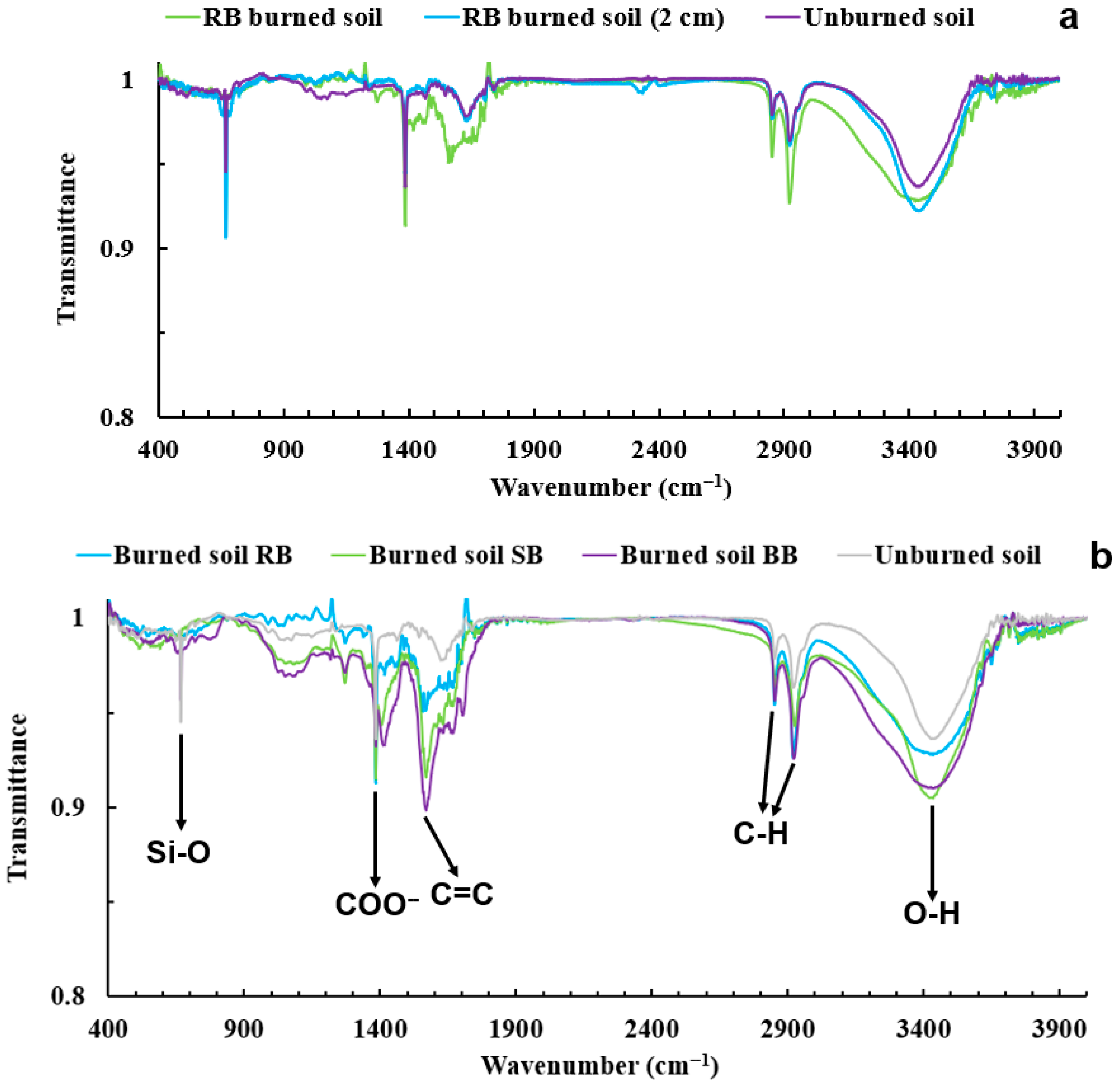


| Sample Name | Sample Description |
|---|---|
| Unburned soil | Background, field unburned soil |
| RB ash | Ash after rabbitbrush burn |
| RB soil mixed with ash | Soil mixed with ash after rabbitbrush burn (burned soil mixed with ash) |
| RB burned soil | Burned soil after rabbitbrush burn |
| RB burned soil (2 cm) | Soil 2 cm deep after rabbitbrush burn |
| SB ash | Ash after sagebrush burn |
| SB soil mixed with ash | Soil mixed with ash after sagebrush burn (burned soil mixed with ash) |
| SB burned soil | Burned soil after sagebrush burn |
| SB burned soil (2 cm) | Soil 2 cm deep after sagebrush fresh burn |
| BB ash | Ash after bitterbrush burn |
| BB soil mixed with ash | Soil mixed with ash after bitterbrush burn (burned soil mixed with ash) |
| BB burned soil | Burned soil after bitterbrush burn |
| BB burned soil (2 cm) | Soil 2 cm deep after bitterbrush burn |
| Fuel | * Active Burning Duration (min) | Maximum Temperature (°C) | ||
|---|---|---|---|---|
| T1 | T2 | T3 | ||
| Rabbitbrush (RB) | ~130 min | 331.4 | 343.8 | 124.4 |
| Sagebrush (SB) | ~260 min | 678.9 | 373.5 | 240.7 |
| Bitterbrush (BB) | ~380 min | 708.6 | 361.7 | 147.5 |
| Sample Name | Averaged Reflectance Values for 400 and 1300 nm Spectral Range |
|---|---|
| Unburned soil | 0.309 ± 0.112 |
| RB ash | 0.246 ± 0.014 |
| RB soil mixed with ash | 0.224 ± 0.092 |
| RB burned soil | 0.257 ± 0.098 |
| RB burned soil (2 cm) | 0.284 ± 0.284 |
| SB ash | 0.196 ± 0.008 |
| SB soil mixed with ash | 0.177 ± 0.075 |
| SB burned soil | 0.240 ± 0.104 |
| SB burned soil (2 cm) | 0.279 ± 0.102 |
| BB ash | 0.343 ± 0.028 |
| BB soil mixed with ash | 0.185 ± 0.069 |
| BB burned soil | 0.220 ± 0.095 |
| BB burned soil (2 cm) | 0.285 ± 0.104 |
| Peak Signal Wavenumber (cm−1) | Corresponding Functional Group | References |
|---|---|---|
| ~667 | Si–O bending vibration related to the presence of silica | [89] |
| ~1384 | COO− stretch, C=O amide the O–H deformation, carbonates, stretching of aliphatic C–H, phenolic groups, asymmetric stretching of COO− (carboxylate), and C=O (carbonyl) groups Associated with SWR Non-polar and hydrophobic Salt of carboxylic acid | [70,89,103,104,109,110,111,112] |
| ~1569 | C=C lignin residues, aromatic rings, hydroxyl group bending vibrations in imogolite and allophane Salt of carboxylic acid | [103,104,116,117] |
| ~2850 | C–H stretching vibration in methyl and methylene groups Non-polar and hydrophobic Associated with SWR carboxylate ion | [89,103,104] |
| ~2920 | C–H stretching vibration in methyl and methylene groups Non-polar and hydrophobic Associated with SWR C–H, C–H2, C–H3 | [89,103,104] |
| ~3419 | O–H vibration, water content | [89,103] |
| Samples | COO−/C–H | O–H/C–H | COO−/C=C | O–H/C=C | C–H/C=C |
|---|---|---|---|---|---|
| Unburned soil | 1.18 | 1.18 | 2.87 | 2.88 | 2.44 |
| RB burned soil | 0.82 | 0.68 | 1.76 | 1.46 | 2.14 |
| SB burned soil | 1.34 | 1.49 | 1.01 | 1.13 | 0.76 |
| BB burned soil | 0.77 | 1.02 | 0.67 | 0.89 | 0.87 |
| RB burned soil (2 cm) | 1.30 | 1.83 | 2.28 | 3.20 | 1.75 |
| SB burned soil (2 cm) | 1.11 | 1.90 | 1.58 | 2.70 | 1.42 |
| BB burned soil (2 cm) | 0.76 | 1.11 | 1.69 | 2.48 | 2.24 |
Disclaimer/Publisher’s Note: The statements, opinions and data contained in all publications are solely those of the individual author(s) and contributor(s) and not of MDPI and/or the editor(s). MDPI and/or the editor(s) disclaim responsibility for any injury to people or property resulting from any ideas, methods, instructions or products referred to in the content. |
© 2025 by the authors. Licensee MDPI, Basel, Switzerland. This article is an open access article distributed under the terms and conditions of the Creative Commons Attribution (CC BY) license (https://creativecommons.org/licenses/by/4.0/).
Share and Cite
Raeofy, Y.; Samburova, V.; Berli, M.; Furtak-Cole, E.; Sion, B.; Houseman, S.; Lu, K.; Curtiss, W.; Andrade, A.J.; Martinez, B.; et al. Physical and Chemical Properties of Fire-Affected Soils from the Sagebrush Ecosystem of the Western US: A Laboratory Study. Soil Syst. 2025, 9, 111. https://doi.org/10.3390/soilsystems9040111
Raeofy Y, Samburova V, Berli M, Furtak-Cole E, Sion B, Houseman S, Lu K, Curtiss W, Andrade AJ, Martinez B, et al. Physical and Chemical Properties of Fire-Affected Soils from the Sagebrush Ecosystem of the Western US: A Laboratory Study. Soil Systems. 2025; 9(4):111. https://doi.org/10.3390/soilsystems9040111
Chicago/Turabian StyleRaeofy, Yasaman, Vera Samburova, Markus Berli, Eden Furtak-Cole, Brad Sion, Sally Houseman, Kristine Lu, William Curtiss, Andrew J. Andrade, Bianca Martinez, and et al. 2025. "Physical and Chemical Properties of Fire-Affected Soils from the Sagebrush Ecosystem of the Western US: A Laboratory Study" Soil Systems 9, no. 4: 111. https://doi.org/10.3390/soilsystems9040111
APA StyleRaeofy, Y., Samburova, V., Berli, M., Furtak-Cole, E., Sion, B., Houseman, S., Lu, K., Curtiss, W., Andrade, A. J., Martinez, B., Khlystov, A. Y., & Moosmüller, H. (2025). Physical and Chemical Properties of Fire-Affected Soils from the Sagebrush Ecosystem of the Western US: A Laboratory Study. Soil Systems, 9(4), 111. https://doi.org/10.3390/soilsystems9040111











